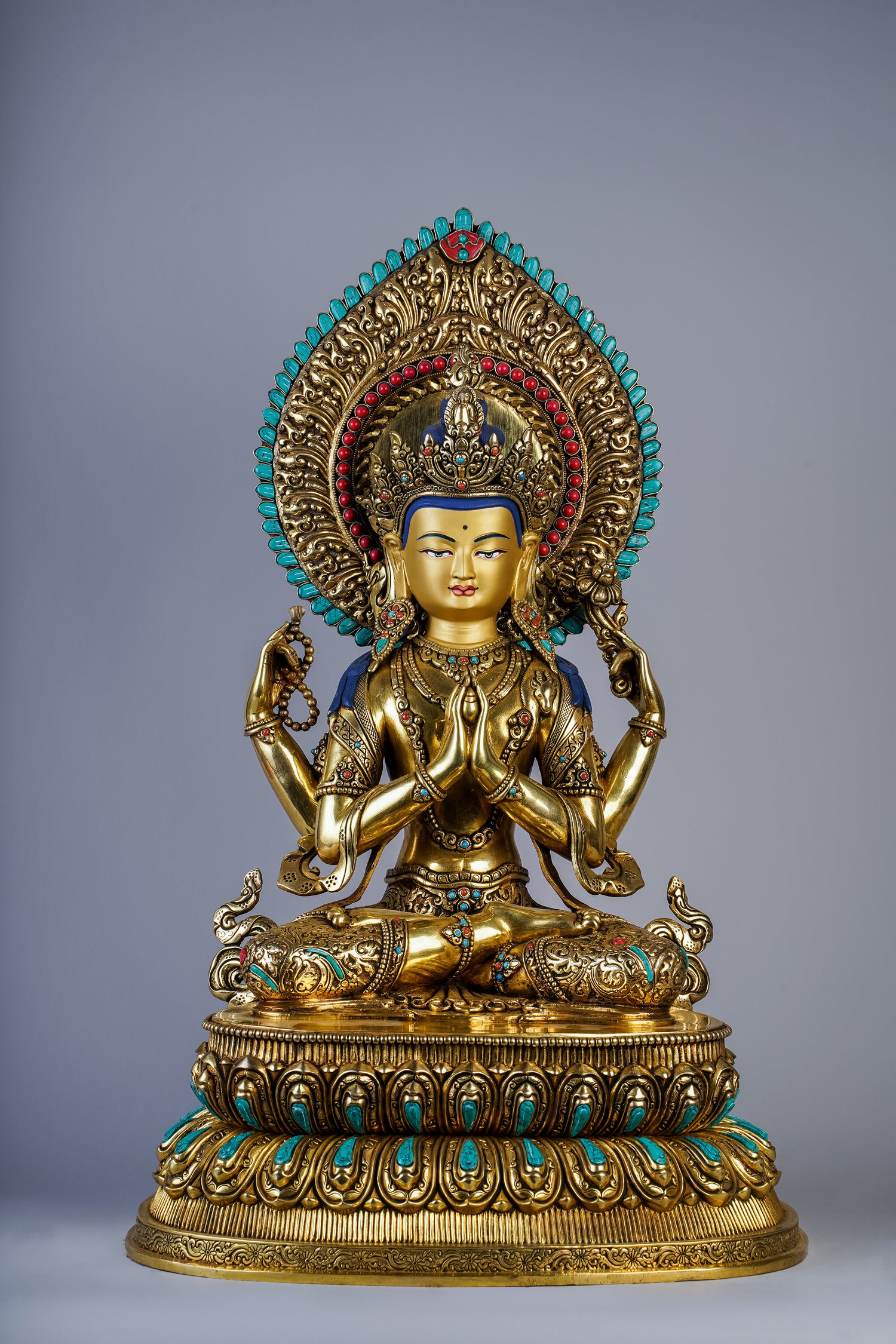
Avalokiteshvera: The Embodiment of Infinite Compassion
Avaloketishvera - སྤྱན་རས་གཟིགས - 四臂觀音
Mantra: Om Mani Padme Hum
Aavalokiteshvara is a Bodhisattva deity symbolizing wisdom and compassion. The name Avalokiteshvara means ‘the Lord who looks upon the world with compassion’ in Sanskrit. In Tibetan Buddhist traditions, this deity is regarded as the sovereign protector of Tibet, often referred to as 'The Protector of the Land of Snows.' In Mahayana traditions, Avalokiteshvara is viewed as a meditational wisdom deity, or yidam, associated particularly with the qualities of Metta, loving-kindness and Karuna, compassion. Avalokiteshvara is also referred as Karunamaya, The Compassionate One and Lokeshvara, The Lord of the whole world, in Kathmandu Valley, Nepal.
Iconography of Avaloketishvera
-

One Face, Infinite Kindness
Avalokiteshvara has one face, which signifies that all phenomena are one in taste, in suchness. His smile radiates in all directions, reflecting his kindness in embracing the world. His eyes are opened utterly wild as the leaves of the Utpala (blue lotus) flower as they behold throughout the six phases.
-

A Gesture of Boundless Compassion
Avalokiteshvara's first two hands are joined in añjali at his heart center, which indicates that he is urging the Buddhas of the ten directions and three times to perform the benefit of beings. As a symbol of his unceasing compassion, his second right-hand holds a mala of white crystal with 108 beads. His left-hand holds a fully blossomed eight-petaled white lotus by the stem adjacent to his left ear, symbolizing that the mud of self-centered thinking does not cover him.
-

Draped with modesty, adorned with liberation
Avalokiteshvara's skirt, made of fine cloth, signifies the character of shame and modesty and is adorned with a jewel-encrusted waist-belt. Because he possesses the elegance of great compassion, his left breast is covered by a cloth of deerskin. Representing the eight forms of liberation, he is adorned with the eight precious ornaments.
-

Seated in awareness
When one understands emptiness, the illusion of self vs other is removed. This understanding gives rise to compassion as one sees suffering as universal, not 'theirs' or 'mine.' On the other hand, compassion helps to create a calm and open mind, the ideal ground for realizing emptiness. Hence, compassion and emptiness are inseparable, which is reflected in Avalokiteshvara's legs seated in the vajra posture.
-

Guidance from the Guru
As Avalokiteshvara is a Boddhisattva of Compassion, people pray to him, seeking mercy or relief from suffering. This is further proven by the presence of his Guru Amitabha on the topknot of his hair, which also symbolizes his teacher's blessings and guidance, as well as the presence of enlightened wisdom at the core of his compassionate activity.
Compassion as the Path to Enlightenment
In the sūtras, the Buddha said that in the beginning, compassion is like the seed without which we cannot have any fruit; in the middle, compassion is like water to nourish the seed we have planted; in the end, compassion is like the warmth of the sun that brings the fruit to ripening. Thus, without compassion, there is no seed of enlightenment, no path to enlightenment, and no fruition of enlightenment. The genuine heart of loving-kindness and compassion is essential in achieving one's freedom from suffering and in attaining freedom for all sentient beings. This shows the significance of Avalokiteshvara in Buddhism.
Rooted in Visionary Origins
It is believed that Thangtong Gyalpo (c. 1361-1485), the composer of Avalokiteshvara Sadhana, led a ritual for the accumulation of one hundred million recitations of the six-syllable mantra when he was young. On the dawn of the eighth day of the month of Magical Illusion, he was given a vision by Avalokita as Khasarpani, the Four-Armed, the Eight-Armed, and the Thousand-Armed-Thousand-Eyed, each body adorned with the major and minor marks.
Seeing this directly, Thangtong Gyalpo offered the seven-branch prayer and other supplications, to which Avalokita responded, "O child of noble family, as I am your master until you attain enlightenment, perform vast activity by means of the six syllables and be a guide to beings!"
The essence of the many instructions that Avalokita directly bestowed upon him at that time is this meditation and recitation of the six syllables, which is profound yet easy to practice.
Although Thangtong Gyalpo led an active public life, he maintained an unwavering dedication to his spiritual life and meditation practice. This dedication is evident in accounts of his numerous sacred visions. The meditation liturgy of Avalokiteshvara is the result of one of such visions, during which Thangtong Gyalpo is said to have received the sadhana from Avalokiteshvara in person.
Today, there are many temples dedicated Avalokiteshvara all over the world, including four popular ones in Kathmandu Valley itself.
References
Other forms of Avaloketishvera
Commonly associated with
Statues of Avaloketishvera: Embodiment of Compassion
-
31 inch/ 81 cm Avaloketishvera | སྤྱན་རས་གཟིགས | 四臂觀音
Regular price $2,945.00Regular price -
13 inch/ 34 cm Avaloketishvera | སྤྱན་རས་གཟིགས | 四臂觀音
Regular price $630.00Regular price -
14 inch/ 36 cm Avaloketishvera | སྤྱན་རས་གཟིགས | 四臂觀音
Regular price $1,000.00Regular price -
14 inch/ 36 cm Avaloketishvera | སྤྱན་རས་གཟིགས | 四臂觀音
Regular price $1,000.00Regular price









